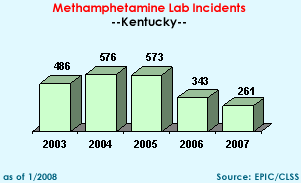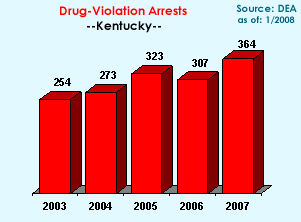|
DEA Offices & Telephone Nos.
Lexington—606-233-2480
London—606-862-4500
Louisville—502-582-5908
Madisonville—270-821-7166 |
State
Facts
Population: 4,173,405
State Prison Population: 17,814
Probation Population: 33,286
Violent Crime Rate
National Ranking: 41 |
2007
Federal Drug Seizures
Cocaine: 147.4 kgs.
Heroin: 0.9 kgs.
Methamphetamine: 7.8 kgs.
Marijuana: 4,813.8 kgs.
Hashish: 3.0 kgs.
MDMA: 0.0 kgs./21,969 du
Meth
Lab Incidents: 261
(DEA, state, and local) |
Drug
Situation: Marijuana, methamphetamine, diverted pharmaceutical drugs, and cocaine are the primary drug threats in the commonwealth of Kentucky. Kentucky is a primary source of domestically grown marijuana, the majority of which is produced in southeastern Kentucky. The commonwealth consistently ranks as one of the top three, marijuana producing states. The Domestic Cannabis Eradication/Suppression Program eradicated 492,615 marijuana plants in Kentucky in 2007. Marijuana produced in Kentucky either remains in the commonwealth or is exported to metropolitan areas in Illinois, Ohio, Indiana, Michigan, and the eastern United States. Methamphetamine manufacturing activity in Kentucky has decreased, but the trafficking of methamphetamine in Kentucky remains because Caucasians are distributing “Ice” methamphetamine supplied from Mexican drug trafficking organizations (DTOs). The abuse and diversion of prescription drugs, particularly hydrocodone and oxycodone, remain one of, if not the, largest drug problem in southeastern Kentucky. The availability of diverted pharmaceuticals in central and northern Kentucky remains at a high level. Cocaine is readily available in central and southeastern Kentucky. Mexican DTOs are the primary source of cocaine from the Southwest Border via regional distribution networks in the Midwest and the southeast.
 Cocaine:Cocaine is readily available in central and southeastern Kentucky. Mexican DTOs are the top-level traffickers and the primary source of cocaine from the Southwest Border via metropolitan areas in the Midwest and southeast. Mexican DTOs supply cocaine to inner-city retail/street level distributors. Mexican trafficking organizations use business fronts, such as restaurants and auto repair/detailing shops, to distribute and launder profits. Inner-city DTOs also obtain large amounts of cocaine from non-Mexican DTOs via motor vehicles and parcel delivery services. The price of cocaine in Kentucky increased during 2007. Gram quantities continue to sell for $100, but ounce quantities increased from the $700-$1,200 range to the $900-$1,200 range, and kilogram quantities increased from the $16,000-$28,000 range to the $23,000-$26,000 range. Cocaine purity levels are consistently in the 40 to 90 percent range. Cocaine:Cocaine is readily available in central and southeastern Kentucky. Mexican DTOs are the top-level traffickers and the primary source of cocaine from the Southwest Border via metropolitan areas in the Midwest and southeast. Mexican DTOs supply cocaine to inner-city retail/street level distributors. Mexican trafficking organizations use business fronts, such as restaurants and auto repair/detailing shops, to distribute and launder profits. Inner-city DTOs also obtain large amounts of cocaine from non-Mexican DTOs via motor vehicles and parcel delivery services. The price of cocaine in Kentucky increased during 2007. Gram quantities continue to sell for $100, but ounce quantities increased from the $700-$1,200 range to the $900-$1,200 range, and kilogram quantities increased from the $16,000-$28,000 range to the $23,000-$26,000 range. Cocaine purity levels are consistently in the 40 to 90 percent range.
 Heroin:
The presence of heroin in Kentucky is limited, but the availability of Mexican Black Tar heroin has risen in the Louisville area. There is a low demand for small amounts of heroin in some areas of southeastern Kentucky. When encountered, heroin has usually been found in user amounts, with the sources of supply from Atlanta, Georgia, or Chicago, Illinois. Heroin:
The presence of heroin in Kentucky is limited, but the availability of Mexican Black Tar heroin has risen in the Louisville area. There is a low demand for small amounts of heroin in some areas of southeastern Kentucky. When encountered, heroin has usually been found in user amounts, with the sources of supply from Atlanta, Georgia, or Chicago, Illinois.
  Methamphetamine:
Methamphetamine continues to be widely available in central and southeastern Kentucky. Primary suppliers of methamphetamine are Mexican DTOs. A decrease in clandestine laboratories/clandestine manufacturing in southeastern Kentucky is countered by importation of “ICE” methamphetamine from Mexico via the Southwest Border, Atlanta, Georgia, and Ashville, North Carolina. Independent traffickers travel to Atlanta and other major cities along the Southwest Border to obtain pound amounts of Mexican produced methamphetamine and smuggle it back into southeastern Kentucky via privately owned vehicles. Small “Mom and Pop” and “Tweaker” operators continue to manufacture methamphetamine in small one to two ounce quantities for personal use and for distribution at the local level. Methamphetamine lab incidents in Kentucky decreased from 343 in 2006 to 261 in 2007 (as of January 2008). Methamphetamine:
Methamphetamine continues to be widely available in central and southeastern Kentucky. Primary suppliers of methamphetamine are Mexican DTOs. A decrease in clandestine laboratories/clandestine manufacturing in southeastern Kentucky is countered by importation of “ICE” methamphetamine from Mexico via the Southwest Border, Atlanta, Georgia, and Ashville, North Carolina. Independent traffickers travel to Atlanta and other major cities along the Southwest Border to obtain pound amounts of Mexican produced methamphetamine and smuggle it back into southeastern Kentucky via privately owned vehicles. Small “Mom and Pop” and “Tweaker” operators continue to manufacture methamphetamine in small one to two ounce quantities for personal use and for distribution at the local level. Methamphetamine lab incidents in Kentucky decreased from 343 in 2006 to 261 in 2007 (as of January 2008).
Pharmaceutical Diversion: The abuse and diversion of prescription drugs, particularly hydrocodone and oxycodone ( Lortab, Lorcet, Vicodin® and Oxycontin), remain one of, if not the, largest drug problem in southeastern Kentucky. The availability of diverted pharmaceuticals in central and northern Kentucky remains high, but stable. The availability of Oxycontin in southeastern Kentucky has risen due to the increased availability of pills transported from Midwest metropolitan areas. Primary methods of diversion include pharmacy theft, “doctor shopping,” prescription fraud, and purchasing large quantities of drugs from unscrupulous Internet pharmacies. The purchasing of drugs via the Internet continues to have a significant impact on Kentucky. Purchasers have the drugs delivered to their homes using false names and/or different combinations of the same name.
 MDMA and other Club Drugs: The availability of predatory drugs in southeastern Kentucky is limited and usually confined to cities where colleges and/or universities are located. MDMA, Ketamine, GHB, and LSD remain readily available and are primarily used by teenagers and young adults in the cities with colleges and universities, such as Lexington, Richmond, and Morehead. The largest suppliers of MDMA are middle-class Caucasian males from 25 to 35 years of age operating in a well-organized manner. MDMA is transported via U.S. Mail from Miami, Cincinnati, Atlanta, and Los Angeles. Distribution to users takes place at strip clubs, bars, Raves, and high school parties. Ketamine is also distributed in nightclubs and bars. Steroids are obtained from mail order companies, doctors, veterinary supply companies, and workout facilities. GHB is obtained through the Internet and from local manufacturers. MDMA and other Club Drugs: The availability of predatory drugs in southeastern Kentucky is limited and usually confined to cities where colleges and/or universities are located. MDMA, Ketamine, GHB, and LSD remain readily available and are primarily used by teenagers and young adults in the cities with colleges and universities, such as Lexington, Richmond, and Morehead. The largest suppliers of MDMA are middle-class Caucasian males from 25 to 35 years of age operating in a well-organized manner. MDMA is transported via U.S. Mail from Miami, Cincinnati, Atlanta, and Los Angeles. Distribution to users takes place at strip clubs, bars, Raves, and high school parties. Ketamine is also distributed in nightclubs and bars. Steroids are obtained from mail order companies, doctors, veterinary supply companies, and workout facilities. GHB is obtained through the Internet and from local manufacturers.
  Marijuana: Kentucky is a major source of domestically grown marijuana. In 2007, Kentucky ranked second in total domestic marijuana production. National Forest lands covering more than 690,000 acres of eastern Kentucky are remote, sparsely populated, very accessible, and possess ideal soil and climate conditions for cannabis cultivation. Marijuana plots on National Forest lands, usually in the deforested areas, are found in various locations from the bottomlands to the hillsides and the tops of mountains. Marijuana growers also perceive the rural areas of National Forest land as too spacious for law enforcement officials to detect their activities. Lastly, growers often plant their crops on public lands in an effort to protect themselves from personal and/or financial loss due to asset forfeiture procedures. Marijuana: Kentucky is a major source of domestically grown marijuana. In 2007, Kentucky ranked second in total domestic marijuana production. National Forest lands covering more than 690,000 acres of eastern Kentucky are remote, sparsely populated, very accessible, and possess ideal soil and climate conditions for cannabis cultivation. Marijuana plots on National Forest lands, usually in the deforested areas, are found in various locations from the bottomlands to the hillsides and the tops of mountains. Marijuana growers also perceive the rural areas of National Forest land as too spacious for law enforcement officials to detect their activities. Lastly, growers often plant their crops on public lands in an effort to protect themselves from personal and/or financial loss due to asset forfeiture procedures.
In 2007, a total of 64,869 marijuana plants were eradicated from National Forest land in Kentucky. National Forest lands suffer from the collateral effects of marijuana cultivation, which includes property damage to natural resources, archeological sites, and wildlife, including endangered species. Marijuana producers have destroyed numerous trees, plants and fauna, as well as gates and fences to clear cultivation sites and drive vehicles to and from the marijuana plots. Far more marijuana is cultivated in Kentucky than the local market can consume. Marijuana grown in Kentucky is transported to the Midwest (Illinois, Ohio, Indiana, and Michigan) and the East Coast.

More information
about the Detroit Division Office.
Sources
Factsheet
last updated:
3/2008
Click
here for last year's factsheet >>
|

